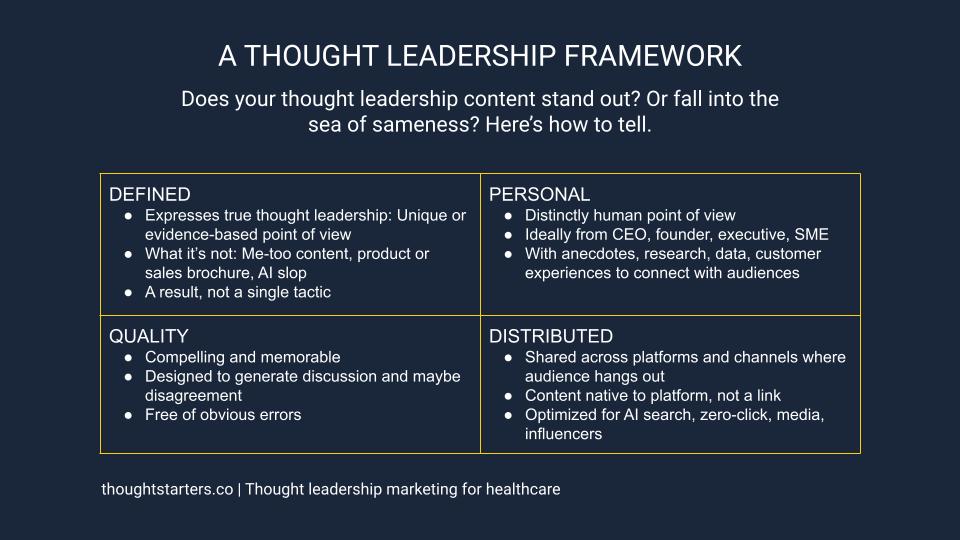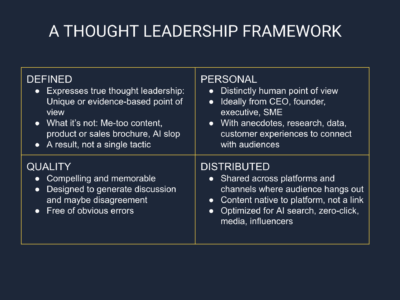Thought leadership is having its moment.
The rush is on to adapt to an AI-influenced world of marketing and communications. With it comes a spike in interest in thought leadership as a form of content (thoughts) from humans (leaders) that AI does a lousy job of creating.
Let’s be clear on one thing: Thought leadership is not new. Since economist and editor Joel Kurtzman first popularized the term in the 1990s, it’s been an easy, if not always accurate, way to tag everything from contributed articles ghostwritten for CEOs with nothing new to say, to data-rich, original research reports that truly influence a market or industry.
One thing that is new is the interest in thought leadership content as an antidote to AI slop. There’s essentially no limit to the number of blog and LinkedIn posts artificial intelligence tools can produce for a leader or subject matter expert.
Of course, AI is a tremendous asset. But it can’t replace human experience, insights, conversations, anecdotes, and storytelling. At least not yet.
In this post I’m sharing the framework I’ve developed for my thought leadership work for clients. The goal is to help anybody in marketing or communications find their way to a successful body of work elevating thought leaders and their insights. This framework draws on personal experience plus approaches from leaders and organizations most often cited for their work in thought leadership marketing.
Uptick in interest? Or explosion?
Just this summer I’ve read a new book called The ROI of Thought Leadership, digested the 2025 edition of the Edelman-LinkedIn Thought Leadership Impact Report, listened to this podcast and this one (both on thought leadership marketing in healthcare), and noticed the dozens of posts about thought leadership that wound up in my LinkedIn feed.
I’ve tracked these types of commentary on thought leadership for a while. This is more than what I typically see in a year, which makes sense given the fears of AI taking over whole swaths of marketing functions, including content marketing.
Now that we’re seeing more founders, CEOs, marketers, and communicators leaning into producing thought leadership content, it seems a good time to ask: How can we improve on the traditional ways of doing thought leadership and make sure it’s a true driver of business value?
Introducing the framework
Here’s an answer! It might not be the answer you’re looking for, since circumstances are unique to each company or leader. But it’s one way of looking at the challenge.
It’s a framework that is:
- Easy to understand and work from
- Based on principles of effective thought leadership refined over the past decade or so
- Focused on the latest distribution approaches that help ideas spread in a zero-click world
- Especially useful for startups and smaller organizations that don’t have the resources of a Fortune 500 company, large institution or global consulting firm
Now, let’s break down this framework:

Defined
The starting point is to consider whether the idea, initiative, or content asset meets any basic definition of thought leadership.
A lot of definitions are out there. I developed my own by cobbling together several that seem to work:
The expression of unique, evidence-based points of view that challenge or engage the target audience’s thinking.
If the idea simply repeats what others are saying, it’s not thought leadership. If it’s centered on a brand’s product or service, it’s not thought leadership.
One other point on definition is to remember that thought leadership isn’t a single activity like pitching and placing a contributed article or landing a speaking engagement. I’ve heard it expressed that thought leadership is a result, not a channel or campaign. I agree with this.
Quality
Next is quality, which almost seems so obvious that it doesn’t need to be called out. Yet too much of what passes for thought leadership isn’t unique, memorable, or even semi-interesting.
Here are some characteristics of quality that I believe should be present:
- Based on unique or evidence-based points of view (see definition above)
- Compelling to read, watch, or listen to
- Memorable; easy for someone to tell a colleague what the main idea is about
- Designed to generate discussion, or in some cases, disagreement, without being controversial just for the sake of getting attention
- Free of obvious errors in logic, facts, grammar, and spelling; avoids phrases many people associate with AI content (“In today’s competitive business climate…”)
Personal
Thought leadership expresses a distinctly human point of view. Readers, viewers, or listeners know almost instantly that it’s not AI-generated. Ideally it bears the stamp of a leader, expressing that leader’s insights, stories, and experiences.
It’s also an idea or insight that the organization stands for. As such, it sends a clear signal to audiences, not contradicting other messaging from the company.
For startups and smaller companies, the founder, CEO, board member, or leadership team member are ideal candidates to be thought leaders. Bigger organizations often have internal experts in specific topics that have built (or are building) a public presence.
Sometimes the brand publishes thought leadership with no author. To create more of a personal connection with the audience, include anecdotes, research or data you’ve generated or discovered, and add named customers, if possible.
Now is a good time to point out that it’s a mistake for companies to throttle public dissemination of an SME’s, or any employee’s, opinions on LinkedIn or elsewhere for fear of having them be poached. Why wouldn’t you want your organization to develop a reputation as a place where talented employees can share their expertise and be recognized for it?
Distributed
Thought leadership does no one any good if it’s not expressed with audiences that matter.
Distribution of thought leadership ideas and content is an area that I see missing in many traditional definitions. Now that marketing and communications must take AI into account, we should do all we can to make sure thought leadership is distributed across platforms and channels where your audience hangs out.
The key here is determining where your audience is, and then developing thought leadership content native to that platform. This is a departure from the old content marketing maxim of “don’t build your house on rented land,” or places that you don’t own or control. You still need a home base for owned content, but you can no longer rely on repeating that content on other platforms and getting links back to your own site.
For this framework I layered in the emerging techniques for sharing content and getting it noticed in an AI world:
- Optimizing for AI results (use your term of choice, like GEO)
- Taking zero-click content into account (creating content native to its platform without relying on links to your site)
- Embracing media and influencer channels (podcasts, Substack newsletters, YouTube videos).
Bottom line: Ideas should be designed to spread. Distribution now carries equal weight to the other factors in making thought leadership successful.
How to use
Here’s the obvious limitation: This is a framework, not a playbook. It’s closer to strategy than to tactics, although a thought leadership strategy would take on a slightly different form. And it can be used to develop the tactics that make sense for your company or leadership team.
No doubt there are different ways to develop a thought leadership framework. If this represents a big chunk of the work you do, you likely already have a framework that works for your unique circumstances. My goal is simply to prompt new thinking about how to approach building authority and reputation for brands, thought leaders, and subject matter experts.


 Want your content to stand out? Start by getting better at interviewing experts
Want your content to stand out? Start by getting better at interviewing experts